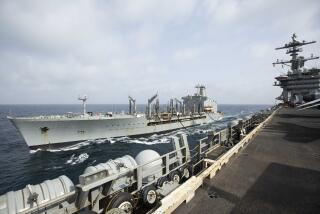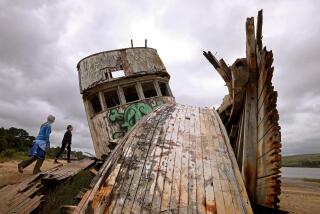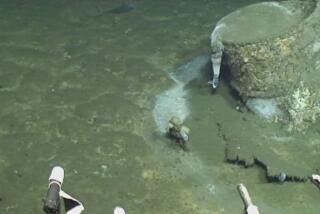Ill-Starred Ship Limps Back to S.D. : Exxon Valdez’s Odyssey Ends as It Docks at Birthplace
SAN DIEGO — It was a homecoming to remember.
The long odyssey of the beleaguered Exxon Valdez ended early Sunday as the crippled vessel, escorted by a flotilla of tugs, Coast Guard vessels and environmentalists in sail and motor boats, crept into San Diego Bay and came to rest at the shipyard of its birth.
The 3 1/2-hour transit, from 3 miles outside the bay to a National Steel & Shipbuilding Co. dock, was a calm and uneventful venture, colored only by crowds of onlookers lining piers to watch the arrival of the infamous vessel.
‘Like Clockwork’
“Everything went like clockwork. It was a piece of cake,” said Capt. Edward J. Silva Jr., the veteran harbor pilot who guided the Valdez through the bay.
The tanker, towed nearly 60 miles from near San Clemente Island, where jutting steel plates were removed from its hull, arrived just outside the bay late Saturday. An underwater survey showed no further hull damage, and Coast Guard Cmdr. Don Montoro cleared the vessel to enter the bay.
Silva slowly maneuvered the ship, which had been drifting off San Diego since July 10 after being towed 2,200 miles from Alaska, under clear early-morning skies through the bay. Four seals lounging on a buoy paid little attention as the flotilla passed and half a dozen helicopters roared overhead.
Coast Guard and Harbor Patrol boats formed a moving safety zone hundreds of yards around the ship in each direction, with vessels carrying pollution-containment and salvage equipment not far behind.
Protest Boats
Alongside the flotilla, eight Greenpeace boats carried environmentalists and signs demanding new energy policies and protesting the oil spill by the Valdez, which one Greenpeace leader called the “tragic symbol of fossil-fuel dependency.”
“Unless we do change course, the lessons of Prince William Sound and the tragedy of the Exxon Valdez will be lost, and it will become just another industrial disaster,” said Kelly Quirke, ocean ecology coordinator for Greenpeace.
The Valdez moored at the Nassco dock about 10 a.m., after tugs turned the vessel around and backed it in. Shortly afterward, a floating containment boom encircled the tanker, and a weary crew, some of whom had been on board since the ship ran aground in Alaska, stepped off.
No discharges like those that sporadically emerged from the Valdez during the last three weeks were sighted during the transit, said Coast Guard Lt. Larry Solberg. “We hope all the problems are behind us,” he said.
Such a placid ending, however, disguises the legacy of the Exxon Valdez.
Before the ship was completed at Nassco in 1986, two workers were killed while building the vessel. Nearly four months ago, the Valdez hit a reef and spilled 11 million gallons of crude oil off the pristine Alaskan shore, marking the worst oil spill in U. S. history.
And, 21 days ago, the tanker arrived off San Diego for repairs, only to be turned away after jutting steel plates were found peeled from its hull and an 18-mile oil slick was sighted nearby.
The jutting plates would have prevented the ship from clearing the bay’s bottom, and had to be removed. And officials wanted to investigate whether the tanker, deemed “squeaky-clean” by Exxon executives before it left Alaska, was still leaking oil.
Jurisdiction Questions
But a tangled, murky web of jurisdiction and responsibility was woven as state officials demanded that Exxon meet stringent conditions before the vessel entered state waters and wrestled with the company about whether the ship had spilled crude off California shores.
For Exxon Shipping Co., the docking of the young but tattered ship marked the close of what company officials saw as an undeserved public-relations nightmare.
“It’s taken four months to get here. We’ve done it safely, and we’ve done it carefully,” said Frank Iarossi, president of Exxon Shipping, who added that the company may change the name of the vessel after it is repaired.
Iarossi, who was on hand for the ship’s arrival at Nassco, steadfastly maintained that the ship had carried no oil from Alaska, and disputed state and Coast Guard findings that the vessel was responsible for several spills of oil off California, including the 18-mile slick.
“I’m denying the Valdez spewed oil (off San Diego). There was no oil on that ship,” he said. “I don’t understand why we still have those questions.”
For state officials, who carefully watched the ship’s entry into state waters and the bay, the matter is far from resolved.
Test results received late Saturday confirmed earlier findings that the 18-mile slick was at least “95%” Alaskan North Slope crude oil, the cargo of the Valdez when it struck a reef in Alaska, officials said.
“I don’t have any doubt whatsoever” that the Valdez was the source of the slick, said Reed Smith, pollution response coordinator for the state Department of Fish and Game. “But it’s hard to deal with a ship owner who says they’ve never had a leak. It’s amazing they’re still denying it.”
Because the original slick and several other sheens believed to have come from the Valdez were found in federal waters, and because the vessel emitted no discharges as it passed through state waters, the state has no jurisdiction to file charges of ocean pollution against Exxon, Smith conceded.
But the Coast Guard is expecting test results from samples of waxy oil residue off the tanks of the Valdez, and that and state evidence could fingerprint the tanker as the source of the spilled oil--and subject the company to federal civil or criminal penalties, he said.
For now, the Valdez will remain moored at its Nassco berth while engineers attach hydraulic supports, study the hull damage and plan how best to maneuver the 166-foot-wide vessel, with more than 30% of its bottom missing, into a 175-foot-wide dry dock.
The maneuver most likely will take place between Aug. 15 and 18, when the tide is high enough to help float the ship into the dock. Then more than 300 new workers, along with a regular Nassco crew of 2,700, will spend nine months patching the shredded hull with 3,000 tons of steel.
“Technically, it’s going to be one of the most difficult things they’ve ever done,” said Peter Zschiesche, a machinists’ union representative at Nassco and a member of the Sierra Club. “We haven’t worked on too many crashed vessels lately.”
For Exxon, the ship won’t be the only company fixture to undergo repairs. Under study now are oil transport and safety policies.
More to Read
Sign up for Essential California
The most important California stories and recommendations in your inbox every morning.
You may occasionally receive promotional content from the Los Angeles Times.










